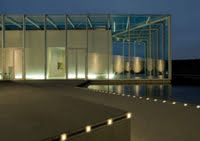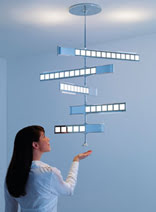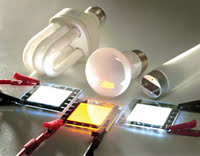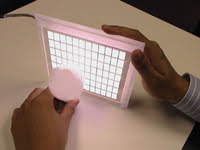Developing OLEDs for the general illumination market
The lighting industry is in transition. The formerly ubiquitous incandescent bulb has already been banned in Europe and will be phased out in the US beginning in 2012, all part of an effort to reduce greenhouse gas emissions by promoting energy efficiency. That leaves a significant portion of the $100 billion global lighting market – more than $20 billion of which is represented by lamps – up for grabs.

Courtesy of Philips.
Compact fluorescent lamps are often considered the obvious successor to incandescent bulbs, since they use as much as 80 percent less energy and last considerably longer, but they have drawbacks as well. They are more expensive individually and give off a harsher light, dramatically changing the aesthetics of an interior. At the same time, consumer advocates have noted that many people – those who suffer from epilepsy and anxiety, for example – are especially sensitive to this light.

This luminaire reacts to movement in the surrounding space. Glowing in response to a presence, it transforms from ambient OLED illumination to provide direct up-and-down LED light as movement increases around it. Courtesy of Philips.
Among the other alternatives, organic LEDs (OLEDs) have lately created a stir, in large part because of improvements in power efficiency. “In the past couple of years, we have seen tremendous advances in OLEDs,” said Janice Mahon, vice president of technology commercialization with Ewing, N.J.-based Universal Display. The company licenses technology and sells phosphorescent materials for use in OLED displays and lighting. “These advances have made it clear that, technically, the industry can get to the kinds of performance numbers it needs to make OLEDs a viable lighting source.”

This white OLED panel from Novaled can be used for lighting applications. Courtesy of Novaled.
Changing the character of light
The fundamental mechanisms of OLEDs are similar to those of LEDs: Applying electricity to a device leads to a recombination of electrons and holes in the conductive layer, resulting in a release of energy in the form of photons – but the emissive materials are organic molecules as opposed to semiconductor diodes. This leads to compelling differences between the two light sources – indeed, between OLEDs and most other forms of lighting. Most significantly, perhaps, OLED panels can be less than 2.5 cm thick.

Organic light-emitting diodes, shown here at bottom in three different colors, offer alternatives to other lighting technologies, such as, from left, compact fluorescent bulbs, traditional incandescent lightbulbs and fluorescent tubes. Courtesy of Philips.
But also, whereas LEDs and other more conventional sources present distinct points of light, OLEDs offer uniform, diffuse light spread across the sheets of material. This changes the character of the light and allows for a degree of transparency in the panel when the source is switched off. With further development, the sheets could even be made flexible.
OLEDs recommend themselves for a number of specialty or niche applications, including emergency signage, automotive applications – for interior and dashboard uses, for example – and architectural lighting features. With the latter, Mahon said, they offer “all kinds of opportunities to create special lighting effects.” A single device could offer either cool or warm light, and even allow tunability so users can design lighting specific to the occasion, be it a business meeting or a dinner party.

OLEDs can be made in various colors, including warm and cold whites, with a very high color rendering index. Courtesy of the OLLA Project.
The flexibility and transparency of OLED sheets, and the availability of lighting as ultrathin panels, open the door to a world of additional possibilities. Lighting designers are already chattering about making decorative wall dividers with OLED panels, incorporating the panels into ceiling tiles and venetian blinds, even wrapping them around columns.
Ultimately, though, whether OLEDs can compete in the general lighting market will depend on both efficiency and cost. For example, using its phosphorescent OLED technology, Universal Display has produced OLEDs with an efficiency of 102 lumens per watt in a small area. (A standard 60-W tungsten incandescent bulb offers efficiency of about 15 lumens per watt; fluorescent bulbs, typically in the range of 50 to 75.) “Now we need to demonstrate the same efficiency on a 6 X 6-in. panel,” Mahon said, adding that costs will begin to drop once production is scaled up.

For general illumination applications, OLEDs offer a viable alternative to conventional sources. They are relatively energy efficient and provide a uniform diffuse light that can even be tunable. OLED lighting panels are also thin, measuring as little as 2.5 cm. Courtesy of Janice Mahon, vice president, technology commercialization, Universal Display.
At the same time, Universal Display and others continue to work toward the US Department of Energy’s 2015 target for general illumination: 150 lumens per watt. To this end, the company is evaluating new materials and device structures and seeking to reduce some of the losses that occur over area in larger-area lighting panels, by using better conductors and scalable outcoupling techniques, for instance.